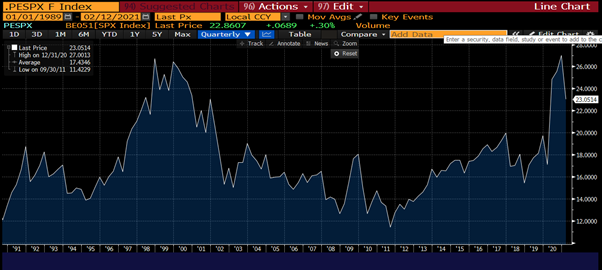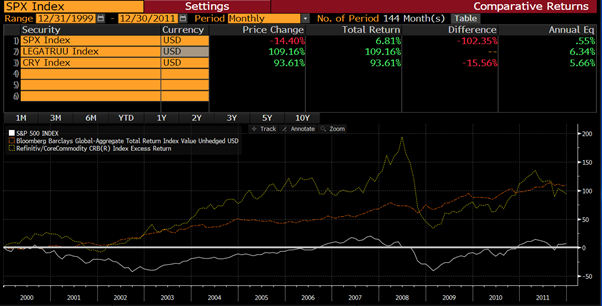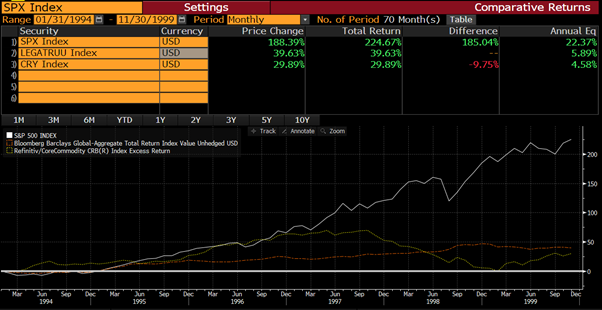Macro Themes and Thoughts September 2021.
- Growth.
-
- Likely to slow from the high pace of recovery.
- + Base effects.
- + Diminishing marginal returns to policy. Also, the need to reset policy to mitigate future crises.
- + Substitution from efficiency to robustness.
- + energy transition may cause loss in efficiency.
- – Innovation in artificial intelligence, energy efficiency, supply chain optimization post re-shoring.
- – continued loose fiscal and monetary policy.
- – redistributive fiscal policy and progressive tax codes.
- Expect oscillations. Amplitude of oscillations may exceed trend growth.
- + Fiscal and monetary policy approaching extremes. Changes in policy may have big impact.
- + Inequality. Social compact stressed. Risk of social instability is high.
- + Climate volatility impact on inflation and policy.
- + Medium term impact of COVID lockdowns still not well known.
- Likely to slow from the high pace of recovery.
For many years global growth rates have been maintained at beyond natural rates through unconventional monetary policy. These policies are reaching their limits. One serious constraint to further monetary stimulus is inflation which has recently risen above targets and forecasts.
Fiscal policy has recently been drafted to help where monetary policy may become less effective. Fiscal policy has in the past faced political hurdles but these have been cleared by the global COVID pandemic. Fiscal policy is a relatively new factor and may be able to drive growth rates further before it faces its limitations. A budget neutral redistributive tax code is also supportive for growth.
One moderating factor in growth rates is the substitution of robustness for efficiency. This was witnessed in the banking and financial sector after the financial crisis of 2008 and is a growing theme with multiple contributory factors including the desire for national self-sufficiency.
- Inflation. Inflation is partly transitory and partly persistent. It is likely that inflation will subside but not to pre 2019 levels.
- Partly transitory.
- Base effects from 2020 lockdowns.
- Recovery from re-opening of economy.
- Supply bottlenecks ease.
- Innovation.
- Partly persistent.
- Substitution between efficiency and robustness.
- Less globalised supply chains.
- Redistributive fiscal policy.
- Net fiscal deficits.
- EM demographics.
- Partly transitory.
After over three decades of modest inflation, prices are rising quickly once again. Much of it has to do with supply chain bottlenecks exacerbated by the COVID lockdowns and fiscal stimulus. If these were the only factors then the central banks would be right in thinking that they were transitory. There are reasons to expect some significant portion of inflation to be persistent.
Fiscal deficits added to monetary stimulus are inflationary. If fiscal discipline was reinstated quickly then this factor might be discounted.
The efficiency versus robustness trade-off is just beginning. The Balkanization of the world economy is driving this need for more robust supply chains. As supply chains are designed for more redundancy and self-sufficiency, cost efficiency falls.
One of the most significant factors in keeping inflation in check was cheap Chinese labour. The last couple of decades have seen Chinese wages rising, and the labour force growth slowing. India still has a young and growing labour force but cannot compensate for a maturing Chinese population. A China plus One production strategy has been adopted by many multinationals for almost a decade now.
Inflation is a failure of human ingenuity, and humans have yet to be beat. Innovation and collaboration have been hallmarks of the species. Advances in robotics, energy efficiency and artificial intelligence may yet prolong the goldilocks environment of growth and moderate price rises.
On balance, it seems that rising inflation has become a reality and is likely to be more persistent than central banks and investors hope.
- Policy
- Fiscal policy gaining more acceptance globally. COVID has led to emergency fiscal deficits breaking the taboo.
- Monetary policy may be limited by inflation.
- Can central banks maintain low rates and asset purchases under rising inflation?
- Coordination of monetary and fiscal policy to manage sovereign debt service.
- Are asset markets also a policy tool?
Expansionary monetary policy balances downward pressure on interest rates and upward pressure on prices. Expansionary fiscal policy puts upward pressure on both rates and prices.
The popular acceptance of fiscal deficit policy has been telegraphed a long way ahead. COVID has provided the justification and acceleration of fiscal policy. Economic analgesics are difficult to wean off. On balance, fiscal deficits can be expected to grow or be more persistent. Even a budget neutral but incrementally progressive tax code will lean towards being inflationary though stimulative.
Monetary policy is expected to be coordinated with fiscal policy to maintain cheap funding for governments and the public sector. The complicating factor is inflation which could force central banks to tighten credit conditions more than they would like.
On balance there is a likely substitution of fiscal policy for monetary policy even as both policies remain expansionary. The result will be gentle pressure on short term interest rates and greater pressure on prices and longer term interest rates to rise.
- Socio-political factors.
-
- Rivalry between US and China.
- How much of this is driven by domestic politics?
- What is the nature of the rivalry? Is it a struggle between philosophies such as communism and capitalism or is it a more prosaic economic and commercial rivalry?
- Consequences for Europe, Africa, Middle East, Rest of Asia?
- Rivalry between US and China.
-
- Central planning versus free market economics.
- Efficiency of each under different assumptions of information completeness. This could, however, mitigate one of the failures of resource allocation under extreme inequality.
- Central planning versus free market economics.
-
- US policy.
- Focus on domestic issues.
- External policy through the lens of domestic dynamics.
- Mid-term elections.
- US policy.
-
- China policy.
- Addressing market failures.
- Free riders.
- Rent extraction.
- Monopoly.
- Inequality.
- Tragedy of the commons.
- Other interventions to maintain balance and stability. Here also is an example of a repositioning from efficiency to robustness.
- Execution risks. To what extent does the means confound the ends?
- Is there a fundamental departure from market economics?
- Addressing market failures.
- China policy.
China is at an inflexion point. The actions of government and regulators could be indicative of a change in paradigm either in favour of more inclusive market economics with its market failures addressed and mitigated, or towards a more oppressive regime of central authority. At the operating level, the policies look the same.
For those who see China as an enlightened communist/market economy, the encouraging signs are that policies seem to be targeting established market failures. The implementation and signalling by the regulators have been awkward and clumsy. There are sufficient elements of excessive control in the new regulations that could support the more cynical view that China is turning away from free market economics. More time and signal are needed before the question is settled.
-
- Inequality.
- Inequality leads to more concentrated resource allocation decision making which is informationally inefficient.
- Inequality impairs the explanatory and predictive power of our economic, social and political models and can lead to policy errors.
- Inequality leads to aggregate over-saving and under-consumption reducing growth rates for a given endowment of factors and money supply.
- – scope for inequality is required to encourage effort and enterprise.
- – patience for trickle-down economics is a function of the age distribution of the population.
- Inequality.
Economists and investors are only just recognising the ills of inequality as regards aggregate over-saving and demand deficiency (see The Saving Glut of the Rich, Mian, Straub and Sufi 2021). A more subtle problem plagues unequal societies in the form of unequal economic voices in the market place of capital allocation and consumption decisions. This can lead to the information processing efficiency of the market economy tending towards that of the centrally planned economy.
- The environment.
- Climate and weather volatility. Amplitude of oscillations may exceed trend parameters.
- Impact on agriculture.
- Impact on shelter.
- Water and food security.
- Inflation and interest rates.
- Climate and weather volatility. Amplitude of oscillations may exceed trend parameters.


